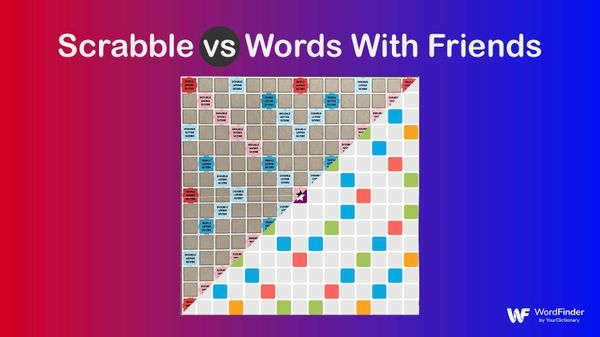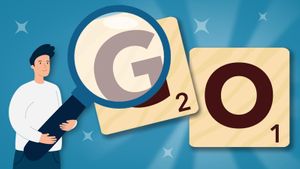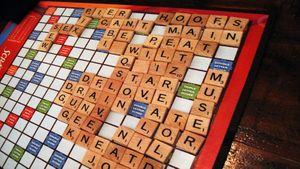Scrabble vs. Words With Friends: Racking Up the Differences

This work is licensed under a Creative Commons Attribution-NoDerivatives 4.0 International License (CC BY-ND 4.0). Please credit WordFinder by YourDictionary.
Classic vs. Modern Word Games
First, we need to make it clear that, for this article, we are discussing the differences between the Words With Friends digital game and the original Scrabble board game. To learn what’s different between Words With Friends and Scrabble’s mobile version, Scrabble GO, read our article comparing Scrabble GO and Words With Friends. The Scrabble GO mobile app offers several unique features over the classic board game.
The Number of Players
Thanks to mobile gaming, we often forget that up to four players can play the original Scrabble at the same time. Yes, the board can get a bit cramped with that many people, but it’s still possible. Scrabble is a party game at its core. It needs the option to let as many people play as it can.
Words With Friends, however, is only a two-player game. Scrabble is a party game, but there’s no denying that it is most fun when played with only one other person. That is the entertainment factor Words With Friends chose to replicate. The one-on-one competition allows players to test their Scrabble word finder skills against each other.
How to Start a Game
To start a game of Scrabble, the first thing you do is reach into the tile bag and pull out one tile. Your opponents do the same. Once everyone has a tile, you compare them all to see which tile is closest to the letter A in alphabetical order. Whoever has the closest letter, or actually drew an “A” tile, makes the first move.
For Words With Friends, deciding who goes first is much simpler, but also less amusing. The only deciding factor is whoever initiated the game. The person who invites you to play a game will always be the first player to make a move.
Dictionary Choice in Scrabble vs. Words With Friends
Scrabble has an official dictionary: the Official Scrabble Players Dictionary (OSPD). However, that’s not the only official Scrabble dictionary. The competitive Scrabble scene has, over the course of decades, created multiple dictionaries that suit their needs. If you and your friends would prefer to use one of these dictionaries, you have the option. Actually, you have the right to use any dictionary you want, as long as everyone agrees to it.
The same versatility isn’t available in Words With Friends. The app automatically checks every word played against its own dictionary. The official Words With Friends word list also contains words not found in the official Scrabble dictionary. And, unfortunately, there’s no option for customization, so you can’t change the dictionary to a different one.
Word Memorization
To excel at Scrabble, you need to have an impressive vocabulary. That doesn’t mean you need to know what every word means, but you do need to know they exist and are valid plays. It needs to be second nature for you to pick them out of the random letters on your tile rack. You also need to be sure what word you’re going to play before you actually play it.
Memorizing words in Words With Friends, while still helpful, is not nearly as crucial. Since you can’t play fake words, and your opponent cannot see what you’re doing until your turn ends, you can test what’s best. That means you can place words on the board — and use a word unscrambler for help — to test their validity and see their value. This helps you pick the best words and placements more easily.
The gameplay dynamics between the two games are quite different, as a result.
Making Bluffs
Sometimes, a Scrabble player won’t have any good words to play. When that happens, they can always make something up. This is called bluffing. It’s the deliberate playing of a fake but real-sounding word for the sake of tricking your opponent. Bluffing is a valid and useful tactic in Scrabble, so don’t be afraid to be crafty when the time is right.
Thanks to the automatic dictionary in Words With Friends, bluffing is simply not an option. If you try to play a fake word, the game simply won’t let you complete your turn. This helps avoid accidentally creating fake words, but it also eliminates one of Scrabble’s unique strategic elements.
Challenging Words
When you think your opponent has played a fake or invalid word in Scrabble, either by accident or on purpose, you can challenge their play before you start your next turn. When you challenge a word, you and your opponent check the dictionary to see if the word is a valid play. If the word is not allowed, your opponent loses the points for that word and doesn’t get to replay their turn. And if the word turns out to be legitimate, you skip your next turn.
Similar to bluffing, Words With Friends’ automatic checking of every word eliminates the need to challenge words. This helps games move more quickly, but avid Scrabble fans might miss the extra difficulty that comes from deciding whether they should challenge a word or not.
Tile Quantity and Values
Each Scrabble board game comes with 100 letter tiles. Aside from the two blank tiles, each tile has a letter printed on it. And there is a set quantity of each letter. Scrabble letter values vary depending on how common the letters are. Common letters like E are worth fewer points, whereas rarer letters like Z are worth much more.
Words With Friends letter values, and the quantities of each letter, are different from Scrabble. There are 104 letter tiles in Words With Friends, compared to Scrabble’s even 100. Some letters are the same — Z is worth 10 points in both games — but Words With Friends tile values are a bit higher than in Scrabble.
Scrabble vs. Words With Friends Board Layout
Scrabble board is a 15 x 15 grid with various score multiplier squares, like double-letter or triple-word, set in patterns across it. You start each game by playing the first word on the center square, which is also a double-word score square.
Word With Friends uses a 15 x 15 board as well, but the layout is not the same as Scrabble’s board. The placement pattern of the score multiplier squares is not the same. The center square is also just a blank, so the first player doesn’t earn any extra points for playing the starting word, unlike Scrabble.
Bingo Values
Every player keeps seven letter tiles at a time on their tile rack. This means, of course, that the greatest number of tiles you can possibly play in one turn is seven. If you use all seven of your tiles at once, that’s called a bingo, and you earn a bonus of 50 points.
Words With Friends players use seven tiles at a time as well. This means that playing all seven letters in a single turn also amounts to a bingo. The difference is that Words With Friends awards 35 points to players for doing so, rather than 50. With the game’s use of power-ups, reducing the bonus points helps to balance the matches.
Weighing the Differences Between More Games
When you stop and take a close look at both games, Scrabble vs. Words With Friends is not some vague comparison. There’s definitely a lot of differences between the two games, and there are pros and cons to both. This is also true of other games that play like Words With Friends, such as Wordfeud and Lexulous. All three games take inspiration from Scrabble, but they also have key differences that make each of them worth playing.
Zac Pricener has been a content creator for the past eight years. He’s a bit of an all-around nerd, and he has a bad habit of working movie and TV show references into conversations whenever possible.



